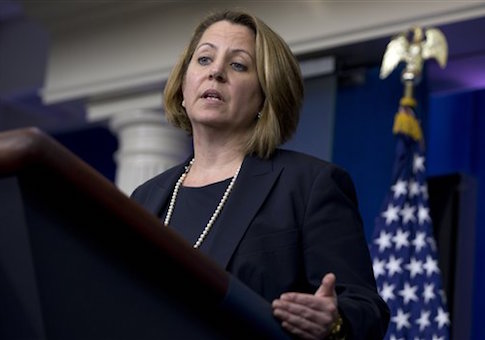President Obama’s top counter-terrorism adviser disclosed on Monday that international terrorist organizations, including ISIS and al Qaeda affiliates, are "planning for sophisticated and coordinated terror attacks," according to determinations made by the U.S. government.
Lisa Monaco, a top counter-terrorism adviser at the White House, warned that the risk of terrorism, both at home and abroad, has reached peak levels, with threat levels becoming "broader, more diffuse, and less predicable than at any time since" the 9/11 attacks.
"We continue to see planning for sophisticated and coordinated attacks, such as those in Paris," Monaco said, referring to last year’s mass attack by ISIS in France. The United States also continues "to disrupt plots also from al Qaeda’s largest affiliate, the Nusra Front, operating in Syria."
"What keeps me up at night is that this threat is unlike what we’ve seen before," she added, referring in particular to ISIS.
The U.S. military and intelligence communities have faced difficulties in combatting the threat due in part to a rise in the number of small, undetectable terror cells and lone wolf radicals who are not formally affiliated with any particular group.
"Terrorism today is increasingly defined by small cells or lone actors, sometimes with little or no direct contact with terrorist organization," Monaco said, referring to the recent terror attacks in San Bernardino, California.
"It was a starkly different kind of attack," she said. "Simply put, the terrorist threat we confront today, almost 15 years" after the 9/11 attacks, "has evolved and done so dramatically."
This new threat is personified by ISIS, which Monaco credited with refining "do it yourself terrorism."
"The primary example of this new type of terrorism is the cancer of ISIL," she explained. "ISIL has eclipsed core al Qaeda as the principal terrorist threat we face."
With its "apocalyptic ambition and an unprecedented brutality," ISIS is a threat "unlike what we’ve seen before," Monaco said of ISIS, which was once described by the Obama administration as an amateur organization.
"ISIL is very different" from al Qaeda, she said. "These fanatics are online and on the ground. They are at once terrorists, insurgents, and bureaucrats."
"The different threat that ISIL poses is a danger we cannot ignore nor underestimate," she added. "This is not an entity we can accommodate. Today, ISIL, in all its manifestations—insurgent army, foreign fighter magnet, social media phenomena, external operations cadre—ISIL is the principal counter-terrorism threat we face as a nation."
Social media poses one of the most complex problems for U.S. counter-terrorism officials.
ISIL has shown that it can successfully recruit and indoctrinate social media users, such as those on Facebook, Twitter, and YouTube, Monaco said, revealing that there are more than 90,000 Twitter accounts associated with or sympathetic to the terror group. Many of these accounts reach more than 50,000 followers.
"Through their use of social media, ISIL has distributed the threat globally," Monaco said. "They can inspire sympathizers and adherents anywhere"
Al Qaeda also remains a challenge, despite taking a backseat to ISIS.
Al Qaeda continues to plan attacks on "American interests" and "has attempted to attack the U.S. multiple times," primarily through its most dominant arm, Al Qaeda in the Arabian Peninsula.
The United States has devised new methods to combat radicalism, including "creating anti-extremist rap music," Monaco said.
Monaco further disclosed that for the first time the Obama administration will reveal in the coming weeks a new report disclosing the number of combatant and non-combatant casualties from U.S. strikes since 2009. The figures will continue to be publicly provided on an annual basis.
The Obama administration has implemented a number of safeguards to prevent civilian casualties.
U.S. military pilots who have returned from the fight against ISIS have disclosed they were not authorized to drop up to 75 percent of their ordnance.
